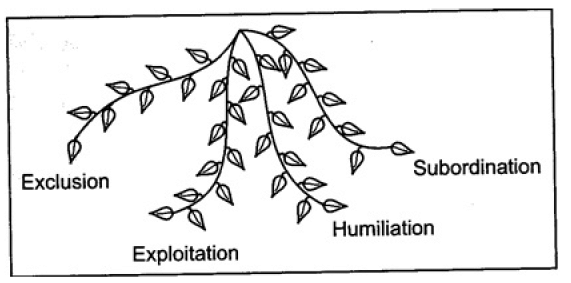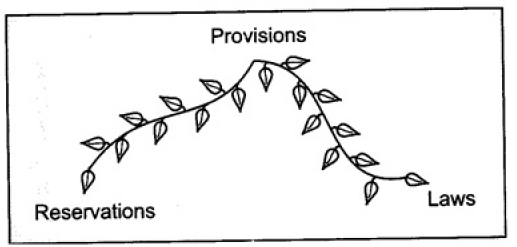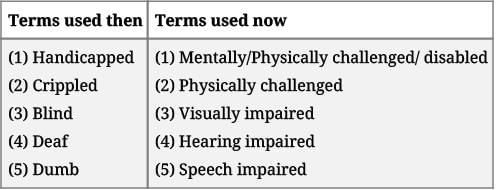Pattern of Social Inequality and Exclusion Revision Notes | Sociology Class 12 - Humanities/Arts PDF Download
Facts That Matter
Social inequality
- Social inequality and exclusion are facts of life.
- The everydayness of social inequality and exclusion often make them appear inevitable, almost natural.
- We often think of them as being ‘deserved’ or ‘justified’ in some sense.
- Life changes and opportunities are not equally available to everyone. They are less for the suppressed castes.
- Patterns of unequal access to social resources are commonly called social inequality.
- Some social inequality reflects innate differences between individuals for example, their varying abilities and efforts.
Social inequality is social because:
- They are not about individuals but about groups.
- Second, they are social in the sense that they are not economic, although there is usually a strong link between social and economic inequality.
- Third, they are systematic and structured – there is a definite pattern to social inequalities.
Social resources
- In every society, some people have a greater share of valued resources – money, property, education, health, and power – than others.
- These social resources can be divided into three forms of capital
- Economic capital in the form of material assets and income
- Cultural capital such as educational qualifications and status.
- Social capital in the form of networks of contacts and social associations.
- Often, these three forms of capital overlap and one can be converted into the other. For example, a person from a well-off family (economic capital) can afford expensive higher education, and so can acquire cultural or educational capital. Someone with influential relatives and friends (social capital) may – through access to good advice, recommendations or information – manage to get a well-paid job.
Social stratification
- Sociologists use the term social stratification to refer to a system by which categories of people in a society are ranked in a hierarchy.
- This hierarchy shapes people’s identities and experiences, their relations with others, as well as their access to resources and opportunities.
Three Key principles to explain social stratification
1. Social stratification is a characteristic of society, not simply a function of individual differences. Social stratification is a society-wide system that unequally distributed social resources among categories of people.
2. Social stratification persists over generations. It is closely linked to the family and to the inheritance of social resources from one generation to the next. A person’s social position is ascribed. The ascribed aspect of social inequality is reinforced by the practice of endogamy. That is, marriage is usually restricted to members of the same caste, ruling out the potential for blurring caste lines through inter-marriage.
3. Social stratification is supported by patterns of belief, or ideology. No system of social stratification is likely to persist over generations unless it is widely viewed as being either fair or inevitable. The caste system, for example, is justified in terms of the opposition of purity and pollution, with the Brahmins designated as the most superior and Dalits as the most inferior by virtue of their birth and occupation.
People face discrimination because:
- Due to their gender, religion, ethnicity, language, caste and disability.
- Prejudices
Preconceived notion/prejudgment - Mostly negative
- An opinion formed in advance of any familiarity with the subject, before considering any available evidence
- Often based on hearsay rather than on direct evidence, and are resistant to change even in the face of new information.
Stereotypes
- Grounded on prejudices
- Fixed and inflexible characterization of people
- Often applied to ethnic and racial groups and to women.
- A whole group is considered homogeneous e.g. Rajputs are supposed to be courageous, girls are emotional, boys don't cry.
Discrimination
- The way you treat people differently in reality
- Disqualify members of on group from opportunities open to others, as when a person is refused a job because of their gender or religion.
- Can be very hard to prove because it may not be open or explicitly stated.
Social Exclusion
• You are isolating them and exclude them from your group.
• When the people who are excluded are not given the opportunities which are given to others; (except their basic food, clothes and shelter) like medical, educational and naturalistic comforts.
• It is not accidental, it is systematic.
• It is openly done.
• It is involuntary, the ones who are excluded don't want to be excluded but we exclude them.
• After centuries, some people who are excluded lean either to ignore or they protest.
• Dalits came up with 2 things.
• They started making their own associations.
• They converted their religion (Muslims and Christians i.e., Islamisation)
• People excluded once the years are still excluded but the issues are changing.
• To bring about change, the mindset of the people has to change.
Caste System as a Discriminatory System
Correlation between Social Status and Economic Status
• There is a very close relation between class and caste.
• The members of the upper caste have better life chances and opportunities to use the resources.
• Now it is changing, people from Shudra community are occupying higher positions and vice versa e.g. K.R. Narayanan-Ex-President who was from a Dalit community. Mira Kumar-Ex Speaker of the Parliament.
• But it is at a micro level in urban areas where Brahmins are peons, clerks while Dalits are doctors and are educated.
• The mindset of the people has not changed, so it is not prevalent at the micro level.
(a) Exclusion: The untouchables went through the worst type of exclusion. They were not given opportunities like others and were excluded from the smallest things and they were excluded from everything.
e.g. They weren't allowed to take water from the wells, pumps or lakes that the Brahmins used. They weren't allowed to take part in festivals, rituals and ceremonies that others would participate in. They had to have a bath with buffaloes and cows.
(b) Exploitation: They were given very low salaries and low grade jobs (washing the bathroom, wetting the roads, cremations).
They were given jobs which no one wanted to do and were not paid. They were treated in inhuman manners and were taken advantage of.
(c) Humiliation: They were not allowed to wear bright clothes full of colour, could not use the same roads, which Brahmins use, had to walk with their heads bowed down while a Brahmin walked by, couldn't walk with their chappals in front of Brahmins so they would hold it in their hands.
They would clean up dead bodies and the cremation and were only included to play the drums from a far off distance.
(d) Subordination: They were below the upper caste and the Brahmins were suppressed.
Provisions by the Government for SC and ST
Reservation
• Laws, Policies, Amendments, Welfare programs.
• They are meant for those who are socially and economically backward as they don't have life chances and opportunities which they should have.
• The government reserves seats for the SC's and ST's and no one else can take those seats from the upper caste.
• They are reserved in educational institutions, jobs, parliament. They have a lot of provisions like age relaxation and low marks for selection.
Laws
• You have to follow the laws.
• It is a legal framework, not like norms.
• Brahmins were the only educated people and the British needed the Brahmins support.
• Laws were made about caste but implementation was poor.
1. Caste disability Removal Act-1850: Introduced because they wanted the lower caste to get into educational institution so that they could study and educate themselves.
2. Abolition of Untouchability-Article 17: If practiced, punishable by law.
3. Prevention of Atrocities Act-1889: The acts, the Brahmins carried out on the lower castes e.g. beating them, not letting them wear bright colors, washing streets, etc.
4. Constitutional Amendment Act-2005: The 93rd amendment. It is to do with education and no one can be devoid of education.
They are still socially, economically and culturally backward.
There are social organisation, associations and political parties and social movements fighting for these classes.
1. Satyashodhak Samaj (Truth Seekers Society) mainly for Dalits and women by Jyotiba Phule.
2. Brahma Samaj]- Raja Rammohun Roy
3. Arya Samaj-Dayanand Saraswati
4. Dalit Sangharsh Samiti
5. Bahujan Samaj Party
6. BSP-Kanchuians
7. Dalit Panther Movement in 1970's
Other Backward Classes (OBCs)
• Those groups of the forward caste who are economically backward.
• These people are very poor and are treated like the Dalits but there is no untouchability.
• Reservations are provided to them since they are illiterate, uneducated and are given the same jobs as the Dalits.
Kaka Kalelkar Commission
• Set up to go to different villages to decide which caste/subcaste should be given the status of OBC.
Mandal Commission
• Large issue in late 80's and 90's.
• V.P. Singh gave reservation in some states but not in other states.
• This led to protests by other people.
Politics of OBC
• Politicians promise reservation for the OBC's only to expand their vote bank.
• Those OBC's that are better off than the other OBC's are upper OBC's.
• The lowest category is equal to the Dalits.
Adivasi Struggle
[anjati's (first inhabitants), Vanjati's (forest dwellers), Adivasi's, Girijans.
• They like to be alone/isolated and their occupations well connected to the forest.
• They were hunter-gatherers, honey collectors, shifting cultivators)
During colonial rule
• Maximum exploitation of forest dwellers.
• Forests were cleared for collecting timber, setting up of roads, railway tracks.
• The tribals who were dependent on the forest lost their livelihood.
• Some of them became thieves and stole timber and poached animals.
• Others went to nearby cities and towns and became laborers working for wages.
• Thus the tribals revolted and protested which led the British to reserve areas known as exclusive areas/partially exclusive areas.
• The non-tribals were not allowed to enter the area, but this was not implemented properly since the weaker sections were sidelined.
After independence
• Development continued to take place so the tribals suffered (roads, railways, tracks had to be made and timber had to be used)
• Hydroelectric projects (dams), using, recreational purposes and the culture of the tribals gets clouded.
• This displaced the tribals and their livelihood was taken away.
• The tribals began revolts, rebellions, protests due to exploitation and discrimination.
• The Adivasi/tribal movement came across and three states were formed Jharkhand, Uttarakhand, Chhattisgarh.
Women structure for equality and rights
• Women are considered to be physically and biologically weaker but they are not socially or economically weak.
• This is due to the patriarchal society and mindset of the people.
Social reformers
• The male reformers wanted to make changes in the society for women and Dalits.
- Raja Rammohun Roy
In 1829 he caused the abolition of Sati Pratha under the Governor General William Bentick. Later he started Brahmo Samaj for the upliftment of the status of women by giving the girl child education.
He wanted child marriage to end and wanted to encourage widow remarriage.
- Dayanand Saraswati
He started the Arya Samaj to educate the girl child. Upliftment of women both socially and economically. Abolishment of child marriage encouraged widow remarriage.
He was against the study of western education and he wanted women to study the Vedas and learn about housekeeping as they would ultimately become home workers. This social work was done by the Arya Samaj.
- M.G. Ranade
He was a Hindu Brahmin and was shocked by the way women were treated. He wrote two books and appealed to the people by saying that even in the Vedas it was not mentioned to treat them badly or they shouldn't get married again.
- Jyotiba Phule
He was a Dalit and started the association called Satyashodhak Samaj (truth seeking society) Focused on status of Dalits and women and was the first Indian to start a college for women in Puri.
- Syed Ahmed Khan
He was a well educated Muslim and he wanted the Muslim women to be educated as they were suppressed, due to the Purdah System but they should learn about housekeeping as they will become house workers.
- Ishwar Chandra Vidya Sagar
He concentrated on widow remarriage. He opposed the way widows were treated.
He encouraged men to marry the widows and arranged community marriages. He did this to give respect to the women.
Women Reformers
1. Tarabai Shinde
- Wrote a book called 'Stree Purush Tulana' in 1882 which spoke about how men treated women.
- She was suppressed, women race were given a very low status.
- Women were ill-treated like slaves.
- There was prevalence of polygamy, so men would marry women.
- She felt that women were degraded and so she wrote the book to spread awareness about the importance of women.
2. Begum Rokeya Sakhawat Hossain
- Wrote an interesting short story, 'Sultana's Dream' in 1915, where there was role reversal (men and women), magical world (satire).
- The man usually worked, stayed there and cooked and did all the household work and women would work, jobs, go in rockets.
- In reality it was very rural for a man to do household work.
- Men should help women and lead them to go out sometimes.
Provisions for women/position/ status of women
• During the 19th century, there were very few associations which fought for women.
• After independence, many women associations came up for the upliftment of women.
Karachi Session of 1931
Few provisions were suggested and later included in the constitution.
1. Everyone is equal in the eyes of law, irrespective of their religion, caste, language and sex they belong to.
2. Women should be allowed to hold positions in society in government jobs, not taking in account their caste, language.
3. Universal Adult Franchise should be allowed to vote irrespective of their caste, religion, etc.
4. All women have a right to vote, right to stand for any office or to take up any job.
Differently-Abled
• The Disabled, who are physically and mentally challenged.
• These terms have changed as these terms are very derogatory and should not be used.
• They are not only physically and mentally challenged but they are socially discriminated and not integrated into society like the mainstream.
• These terms are used loosely and are considered as insults.
Features
1. It is biologically given/genetic.
2. Can be due to accidents (physically impaired).
3. The blame goes to Karma/fate.
4. They are considered to be victims of fate and are fiercely independent.
5. Everything that they do is attributed to their disability. People show sympathy and pity, but they don't want it.
6. Disability is linked with their self-perception (fiercely independent) whether they have a poor perception of themselves.
7. We feel that the disabled people are in need of help.
- In the past, in the mythological movies, the negative character is a differently-abled person.
- The differently abled are discriminated but society does not accept them.
Differently-Abled and Poverty
• They do not have the life chances, opportunities that the others have.
• They are not educated, cannot get jobs and this leads to poverty.
• If they are not accepted by their family, it leads to begging.
• Due to poor conditions, unsanitary conditions, improper health and education, mother has too many children, no polio drops lead to disabilities (inadequate immunization, one crowded housing)
• According to the 2001 census, 2.19 crore people in India are physically challenged.
• The differently-abled began protesting and forming associations and laws by the government.
1. Nowadays in the malls and airports, there is bathroom for them.
2. There are separate educational facilities but they want to be integrated with the mainstream.
3. Provisions are being made in schools, courts, malls, airport, like parking, ramps, lifts, buses-but it is not enough.
4. Most of the hospitals don't have ramps.
• The awareness is increasing but the number of disabled is also increasing.
|
62 videos|151 docs|25 tests
|
FAQs on Pattern of Social Inequality and Exclusion Revision Notes - Sociology Class 12 - Humanities/Arts
| 1. What is social inequality and exclusion? |  |
| 2. How does social inequality and exclusion manifest in society? |  |
| 3. What are the consequences of social inequality and exclusion? |  |
| 4. What are some strategies to address social inequality and exclusion? |  |
| 5. How does social inequality and exclusion relate to the arts and humanities? |  |





















